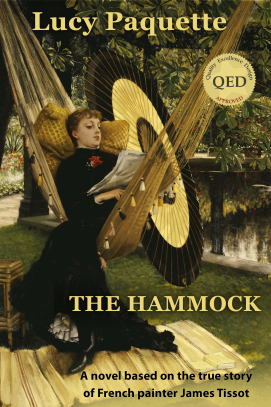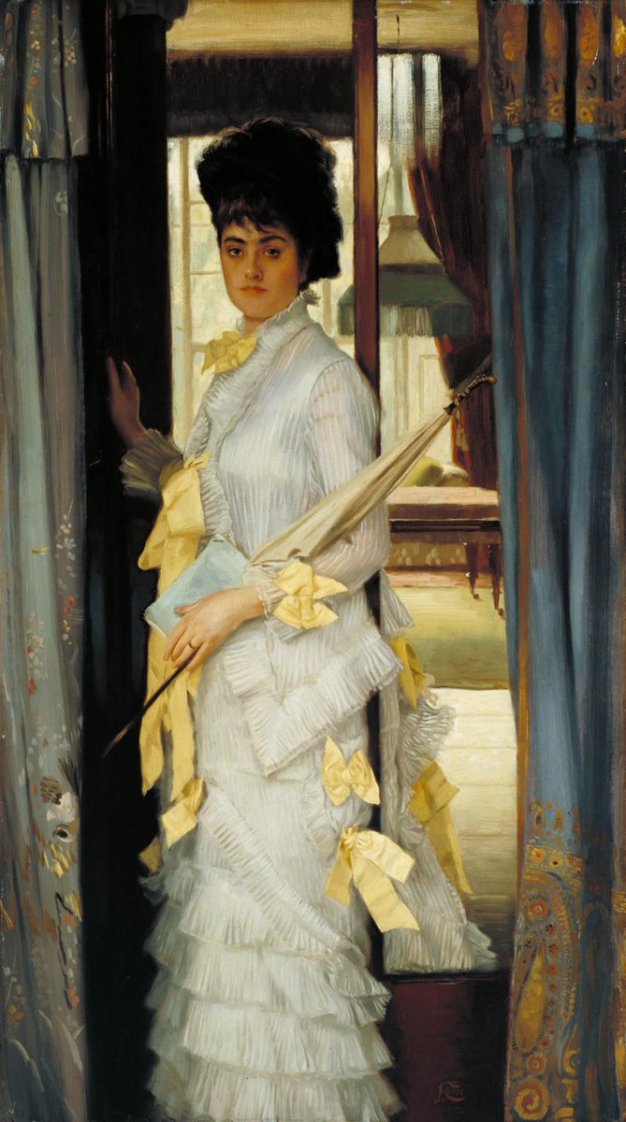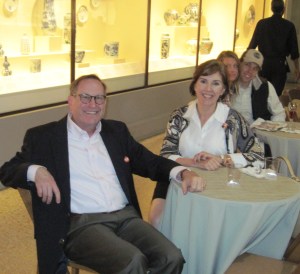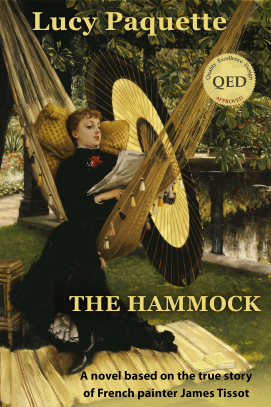To cite this article: Paquette, Lucy. “Kathleen Newton by James Tissot: eight auctioned oil paintings.” The Hammock. https://thehammocknovel.wordpress.com/2013/05/28/kathleen-newton-by-james-tissot-eight-auctioned-oil-paintings/. <Date viewed.>
All auction prices listed are for general reader interest only, and are shown in this order: $ (USD)/ £ (GBP). All prices listed are Hammer Price (the winning bid amount) unless noted as Premium, indicating that the figure quoted includes the Buyer’s Premium of an additional percentage charged by the auction house, as well as taxes.
You won’t often see an image of James Tissot’s mistress and muse, Kathleen Newton (1854–1882), in an art museum, as most are in the hands of private collectors. The divorced mother of two was in her twenties when the wealthy and popular French painter, eighteen years her senior, captured her beauty and elegance for posterity.
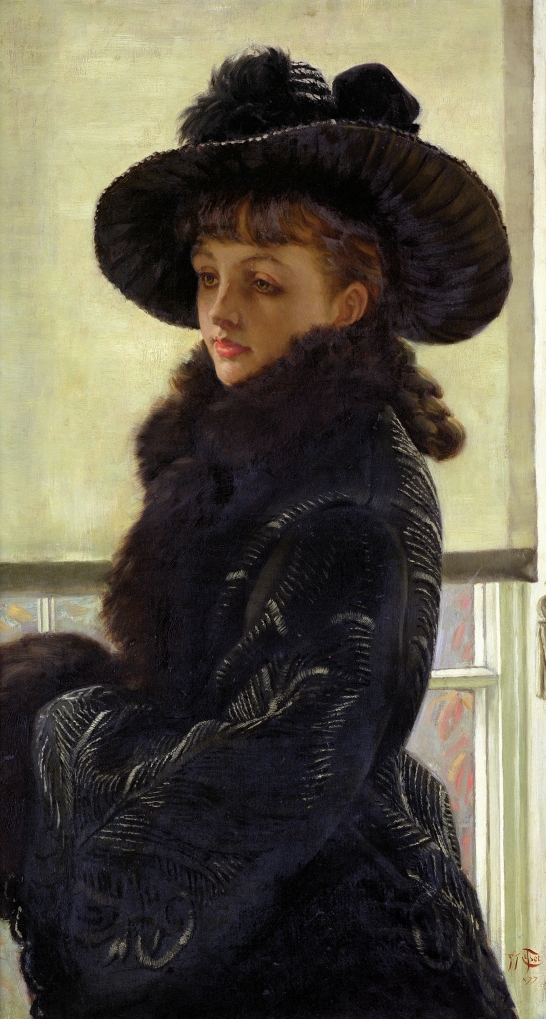
Mavourneen (Portrait of Kathleen Newton), 1877. Oil on canvas, 36 by 20 in./91.44 by 50.80 cm). Photo courtesy of The Bridgeman Art Library for use in “The Hammock: A novel based on the true story of French painter James Tissot,” © 2012 by Lucy Paquette
Tissot’s 1877 Mavourneen (Portrait of Kathleen Newton) had been in a private collection in Australia before it was purchased by Theodore Bruce, Adelaide at Christie’s in 1984. By the next year, it was with the Owen Edgar Gallery, London. In 1995, it was sold to an American collector at Christie’s, New York for $ 2,300,000/£ 1,433,915. The painting, in which Mrs. Newton wears the same ensemble as she does in October (1877), was last exhibited at the Delaware Art Museum in Wilmington from November 28, 2006, through March 30, 2007. Kathleen Mavourneen was a popular love song of the time (“mavourneen” means “my darling”), as well as a play by William Travers, which enjoyed a revival at the Globe Theatre in July 1876.

Spring (c. 1878), by James Tissot. Oil on canvas, 56 by 21 in./142.24 by 53.34 cm. (Photo: Wikimedia)
Tissot’s Spring (c. 1878) brought $ 1,572,556/£ 920,000 at Christie’s, London in 2003. It is now in the collection of Juan Antonio Pérez Simón (b. 1941), a Spanish telecommunications billionaire and naturalized Mexican citizen who has the largest private art collection in the world. He began collecting in his early 20s, and he now owns over 3,000 paintings representing artists from fourteenth-century Italy and the German Renaissance to El Greco, Rubens, Canaletto, Goya, Pissarro, Monet, Renoir, Van Gogh, Gauguin, Cézanne, and Dalí. Many of the paintings normally hang in Pérez Simón’s six homes, but he plans to leave them to a museum to be built in Mexico City. His collection is also the largest private collection of Victorian art outside Great Britain.

L’Ete/Summer (1878), by James Tissot. Oil on canvas, 36 by 20 in./91.44 by 50.80 cm. (Photo: Wikipaintings)
The Paris-based art dealership Goupil & Cie purchased L’Ete (Summer) from Tissot in 1878, the year it was painted, for £220 (5,500 francs). By 1884, it was in the possession of Philadelphia art dealer and critic Charles Field Haseltine. By 1908-09, it was owned by John Francis Brice, Paris. It passed to his son-in-law, Fitch Monroe Briggs, and then to his son, John Kirkpatrick Briggs, Massachusetts. It was sold by the Estate of John Kirkpatrick Briggs at Sotheby’s, New York in 2002, and in 2007, it was sold again – for $ 1,484,700/£ 750,000 at Christie’s, London.
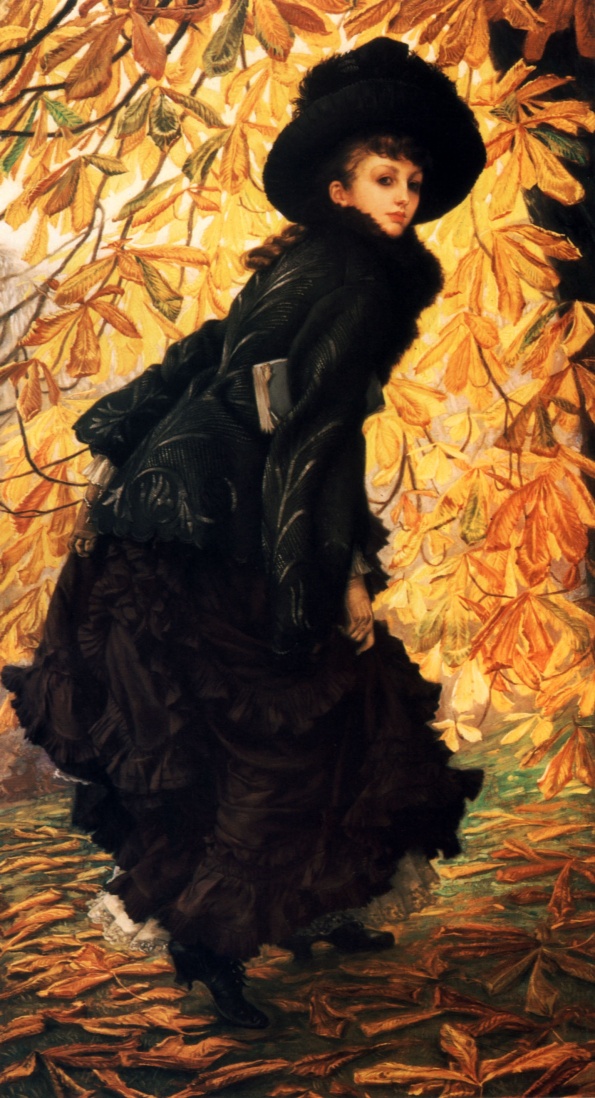
October (1877), by James Tissot. Musée des Beaux-Arts de Montréal. (Photo: Wikipedia)
In 1878, Tissot painted a small oil replica of October (1877), in the collection of the Musée des Beaux-Arts de Montréal since 1927. The original is 85 by 42.8 in./216 by 108.7 cm, while the replica measures 45.5 by 20.5 in./115.57 by 52.07 cm. As of 1985, the replica’s whereabouts were unknown. But in early 1995, the replica was sold at Sotheby’s, New York for $ 2,800,000 USD/.£ 1,775,185 GBP.
_by_James-Jacques-Joseph_Tissot.jpg)
A Winter’s Walk (Promenade dans la neige) (c. 1878), by James Tissot. Oil on canvas, 31.10 by 14.57 in./79.00 by 37 cm). (Photo: Wikimedia.org)
The exquisite A Winter’s Walk (Promenade dans la neige) (c. 1878) has belonged to a number of private collectors over the decades: J.C. Haslam Esq., 32 Queen Anne Street, Cavendish Square, London, whose executors sold it at Christie’s in 1900 to London-based art dealer Arthur Tooth. By 1937, it was owned by Mrs. Bannister, and by 1956 by Henry (Harry) Talbot de Vere Clifton, Lytham Hall, Lancashire. Christie’s sold it once again in 1965, to Leger Galleries, London. It was in a private collection when it was sold by Sotheby’s, London in 1996, to another collector, for $619,160/£ 400,000.

A Type of Beauty (1880), by James Tissot. 23 by 18 in./58.42 by 45.72 cm). (Photo: Wikipaintings.org)
A popular Tissot image of Kathleen Newton, A Type of Beauty (1880), sold at Sotheby’s, New York 1989 for $ 675,000/£ 385,560. In 1991, it sold at Christie’s, London for $ 273,760/ £160,000. But in 1882, at Christie’s, London, no buyer could be found for it at £ 67 4s!

Quiet (c. 1881), by James Tissot. 13 by 9 in./33.02 by 22.86 cm). (Photo: Wikipaintings.org)
Quiet (c. 1881) was bought by Richard Donkin, M.P. (1836 – 1919), an English shipowner who was elected Member of Parliament for the newly created constituency of Tynemouth in the 1885 general election. The small painting remained in the family and was a major discovery of a Tissot work when it appeared on the market in 1993, selling for $ 416,220/£ 280,000. In perfect condition, it shows Kathleen Newton and her niece, Lilian Hervey in the garden of Tissot’s house at 17 Grove End Road, St. John’s Wood, in north London. It was Lilian Hervey who, in 1946, publicly identified “La Mystérieuse” – the Mystery Woman – as her aunt, Kathleen Newton.
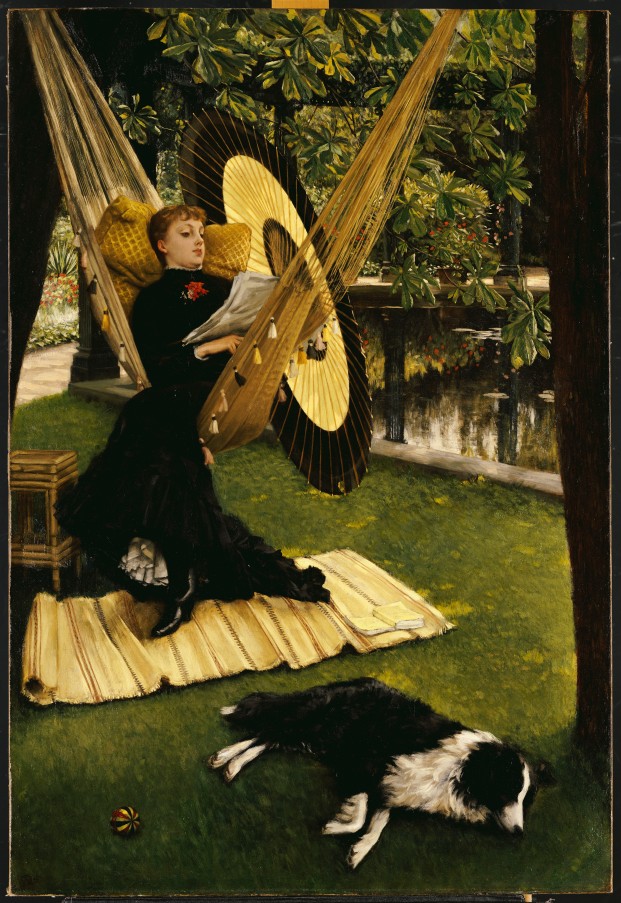
The Hammock (1879), by James Tissot. Oil on canvas, 50 by 30 in. (127 by 76.20 cm). Image courtesy of The Bridgeman Art Library for use in “The Hammock: A novel based on the true story of French painter James Tissot,” © 2012 by Lucy Paquette
And, of course, The Hammock (1879), was sold by Christie’s, London in 2001 for $ 1,708,800/ £1,200,000. It had not been seen in public since it was first exhibited at the Grosvenor Gallery the year it was painted.
“James Tissot was a charming man, very handsome, extraordinarily like the Duke [then, Prince] of Teck. He was always well groomed, and had nothing of artistic carelessness either in his dress or demeanor. At one time he was very hospitable, and delightful were the dinners he gave. But these ceased when he became absorbed in a grande passion with a married woman who, to his great grief, died after he had known her but a brief time.”
Louise Jopling, Twenty Years of My Life, 1867–1887, London, John Lane, New York, Dodd, Mead, 1925
For other images of Kathleen Newton, see my related blog posts:
A spotlight on Tissot at the Met’s “Impressionism, Fashion, and Modernity”
Tissot vs. Whistler, Degas, Manet & Morisot oils at auction
James Tissot’s Model and Muse, Kathleen Newton
© 2013 by Lucy Paquette. All rights reserved.
The articles published on this blog are copyrighted by Lucy Paquette. An article or any portion of it may not be reproduced in any medium or transmitted in any form, electronic or mechanical, without the author’s permission. You are welcome to cite or quote from an article provided you give full acknowledgement to the author.
If you do not have a Kindle e-reader, you may download free Kindle reading apps for PCs, Smartphones, tablets, and the Kindle Cloud Reader to read The Hammock: A novel based on the true story of French painter James Tissot. Read reviews.
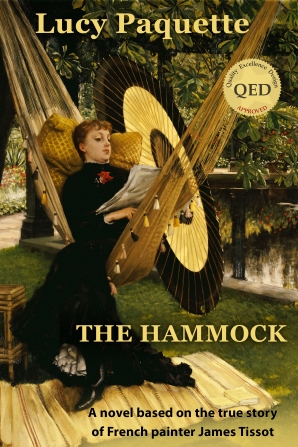 The Hammock: A novel based on the true story of French painter James Tissot, brings Tissot’s world from 1870 to 1879 alive in a story of war, art, Society glamour, love, scandal, and tragedy.
The Hammock: A novel based on the true story of French painter James Tissot, brings Tissot’s world from 1870 to 1879 alive in a story of war, art, Society glamour, love, scandal, and tragedy.
Illustrated with 17 stunning, high-resolution fine art images in full color
Courtesy of The Bridgeman Art Library
(295 pages; ISBN (ePub): 978-0-615-68267-9). See http://www.amazon.com/dp/B009P5RYVE.



 The Japanese Scroll (c. 1874) provides a glimpse of an interior from Tissot’s home in London, either 73 Springfield Road (now demolished), where he lived for a year from March 1872 to 1873, or his new Grove End Road house nearby. It was sold at Sotheby’s, London in 1985 for $ 285,802/£ 220,000. In 2009, it was sold at Christie’s, New York for $722,500/£ 446,787 (Premium).
The Japanese Scroll (c. 1874) provides a glimpse of an interior from Tissot’s home in London, either 73 Springfield Road (now demolished), where he lived for a year from March 1872 to 1873, or his new Grove End Road house nearby. It was sold at Sotheby’s, London in 1985 for $ 285,802/£ 220,000. In 2009, it was sold at Christie’s, New York for $722,500/£ 446,787 (Premium).













